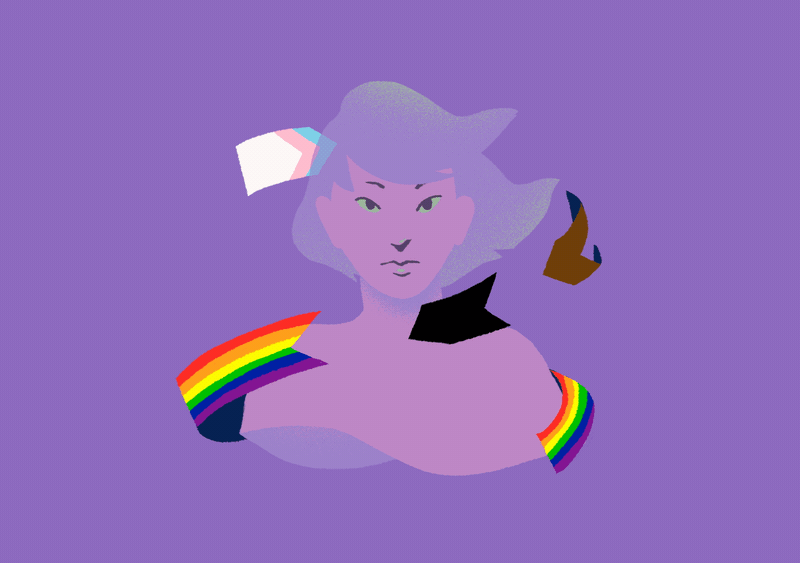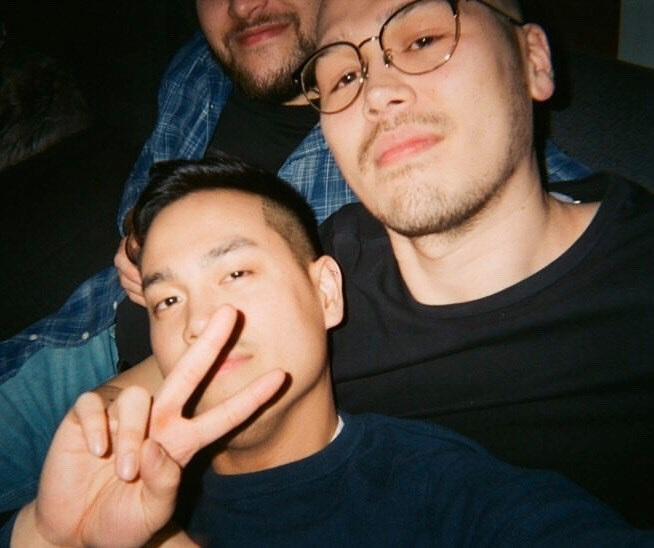VOLUME 2 / ARTICLE 02 ︎
DO QUEER ASIANS EVEN EXIST?
Part 1: A Familial Juggling Act
Part 1: A Familial Juggling Act
Written by Diamond Yao
Photos courtesy of Shawn Suyong Yi Jones and JP Marababol
Illustrations by Maylee Keo
November 2020
Photos courtesy of Shawn Suyong Yi Jones and JP Marababol
Illustrations by Maylee Keo
November 2020

Note to reader: This article is the first in a three-part series that explores different
facets of the invisibility of queer Asians in Montreal. Due to the sensitive nature of this
topic, many of the people interviewed for this article only agreed to speak with me on
condition of total or partial anonymity. Reasons cited were fear of professional
repercussions, desire to protect their family, desire to keep their privacy, fear of legal
repercussions for criminal activity, and desire to stay partially in the closet. As such,
pseudonyms and initials will be italicized in this text. Real names will remain unformatted.
With her Stitch shirt and silvery hair, Linh (pseudonym) doesn’t look like someone who forged a path for many queer Asians in Montreal. A 37-year-old cis woman who identifies as asexual and aromantic, “for the most part”, the self-described Vietnamese-Montrealer “corporate lackey” has been around the Montreal queer scene for a while and wants to bust queer Asian invisibility. Despite the invisibility of that population, Linh is confident that there’s more of us than is apparent. Young queer Asian people in Montreal who are 25 years old and younger are more visible than ever. “A lot of queer Asians are here in Montreal. [...] In my age group, there is actually also a lot of queer Asians but most of them are closeted. So, you’re never gonna hear about them because they are either closeted or semi-closeted or simply not on the scene and don’t communicate with others, found somebody in life and simply settled down and never talked about it again.”
With her Stitch shirt and silvery hair, Linh (pseudonym) doesn’t look like someone who forged a path for many queer Asians in Montreal. A 37-year-old cis woman who identifies as asexual and aromantic, “for the most part”, the self-described Vietnamese-Montrealer “corporate lackey” has been around the Montreal queer scene for a while and wants to bust queer Asian invisibility. Despite the invisibility of that population, Linh is confident that there’s more of us than is apparent. Young queer Asian people in Montreal who are 25 years old and younger are more visible than ever. “A lot of queer Asians are here in Montreal. [...] In my age group, there is actually also a lot of queer Asians but most of them are closeted. So, you’re never gonna hear about them because they are either closeted or semi-closeted or simply not on the scene and don’t communicate with others, found somebody in life and simply settled down and never talked about it again.”
“Coming out to [my mother] isn’t just an individual thing [...] I knew it would reflect on
her within the larger Korean community. That was something that I was always thinking about.
How would this make her look? I was always concerned about her in some ways, I was trying to
protect her at the expense of not being honest with myself.”
Coming Out As A Collective Choice
It is difficult to connect with queer Asian people in Montreal, as many of them are closeted to varying degrees. Unlike Westerners who may value a more explicit declaration of queerness, many Asians prefer a much subtler approach. Coming out for Asians has many facets. It is a loaded experience that the Western world doesn’t always understand. It is a decision Shawn Suyong Yi Jones agonized over. “The last people I came out to were my parents. The reason for that was because there were all these kinds of social and cultural elements that I felt made it very difficult to come out to them. Ultimately, I just didn’t want to disappoint them,” he says, “I think there’s a lot riding on me in terms of expectations. I was put on some sort of pedestal to be the ideal son. Carrying that burden made it extremely difficult.” Shawn grew up in the South with a White American father and a Korean mother, and is now comfortably settled in Montreal with his boyfriend. Looking back, he found it overwhelming to navigate the complex layers of coming out. “Coming out to [my mother] isn’t just an individual thing [...] I knew it would reflect on her within the larger Korean community. That was something that I was always thinking about. How would this make her look? I was always concerned about her in some ways, I was trying to protect her at the expense of not being honest with myself,” he says. His concern for his mother made him much more selective in who he came out to, an approach every person I talked to for this article chose to take.
No Words to Describe Queerness
Because of a pervasive cultural taboo around sexuality, queer Asians often struggle with their personal understanding and reconciliation with their queerness. “Sexuality is just something that is not talked about in my household. I think it’s pretty typical of Asian households. I just grew up not talking about dating people,” said S., an undergraduate student of Malaysian descent who identifies as bisexual and uses she/they pronouns, whose home country still criminalizes homosexuality. Not having opportunities to talk and explore sexuality paired with the constant antagonization of the LGBTQ+ community from her entourage eventually led to S.’s internalized homophobia. Now a young adult, she wished her family would have had a more open conversation about sexuality when she was younger. Having messages around homosexuality that weren’t exclusively negative from her environment would have helped her.
 Down time! JP posing in a park with a chip.
Down time! JP posing in a park with a chip.
Jon Paul “JP” Marababol, a 24-year-old Filipino-Montrealer who identifies as non-binary and gay, credits their traditionally Asian and religious upbringing for their struggle in understanding their queerness, “I grew up Catholic [...] learning that there’s two genders and that there wasn’t a grey area.” As they started to become more comfortable with their queerness, they realized that they have always been non-binary but lacked the language to express it. It was only in their twenties when JP was questioning and got involved with the queer community. It was there that they realized that there were names for such non-binary identities. Linh had a similarly tortuous journey of self-discovery that resulted in a relatively late coming out. Not knowing what asexuality or aromanticism was, she thought she was bisexual. Since she didn’t like being asked out by people of either gender, she assumed she was OK with both. She came out to her mother as bisexual at the age of 18 before stumbling on the Asexuality Visibility and Education Network (AVEN) online. It was a revelation that led her to come out again as asexual to her mother at 21, which fell on deaf ears. Linh attempted it again when she was 25 after her father and brother suggested she try dating. By then, her mother had done some research on asexuality online and understood her better. It was the first step Linh’s mother took in the eventual acceptance of her asexuality.
Is It Easier With Rebel Parents?
An endless cycle of coming out seems to be the norm among queer Asians, especially those who have diverse queer identities such as A.L., a 26-year-old Vietnamese-Montrealer who identifies mostly as a straight trans man. Prior to presenting as male, A. L. came out to his mother in his late teens as lesbian when he was in his first relationship with his girlfriend. Before that, she had already suspected something even though nothing was ever said. His mother reacted positively. Separated from his father when he was three months old, A.L. and his mother had been living with her female partner since he was five. Having a queer parent made it easier for A.L. to come out, “I never thought for one second that my mom would be disappointed or whatnot when I came out. I just did it in the car.” However, it didn’t spare him from hardships when he had to come out as a trans man, even within the queer community. When he started hormone therapy, he came out to his mother but didn’t think she understood at the time. “She thinks I suddenly chose to be a man. Most people think like that. But it’s not a choice that I make, so I had to explain”, he said. To her credit, his mother is actively making efforts to use the appropriate pronouns. Her partner, however, still refers to him as “she.” This is an issue that persists even after his mother repeatedly tried to correct her. To cope, he has been avoiding his mother’s in-laws. “They’re not bad people, I just don’t want to get into a bad mood that’s just gonna ruin the whole thing. So, I’m just taking precautions for myself and for them [...],” he said. “Before, I’d just get sad, but now, I actually get pissed. When I get pissed, I do and say things that aren’t really respectful. I don’t want to risk doing that.”
It can be emotionally challenging to grapple with how unaccepting of queerness parents who themselves have defied sociocultural norms can be. When I asked Shawn how his parents, who had to defy sociocultural expectations to marry each other, could have such openness toward interracial relationships but be resistant against queer relationships, he became pensive. He came out to his parents by writing a letter in English to his father and in Korean to his mother. Even though he is more fluent in English than in Korean, he felt that it would be best to communicate with his mother in her native language to convey ideas and nuances that can only be expressed in Korean. In his letters, he asked his parents to understand his situation by referring to their own experiences struggling with acceptance from their parents. Their reactions were mixed.
“For queer Asians, finding personal freedom in queerness doesn’t necessarily make it easier for them to embody it around their family.”
Finding And Being Yourself Around Family
Many Asians’ apprehension around queerness is in large part due to the unfamiliarity of queerness in Asian cultures. This type of apprehension not only hinders the acceptance of queer Asians in the Asian community, but also hinders queer Asian’s own self-acceptance journey. Shawn only started to become comfortable with his queerness in his early adulthood after lonely teenage years of trying to repress it. At the conservative Southern university he attended for undergrad, as a result of diversity initiatives, he worked as university residence staff alongside other queer people of colour. It was within this community of colleagues that he started to become confident as a gay man. It was also in university that S. found a supportive community of queer friends of colour who helped her grow into her queerness. Studying in Canada, a country that has more open attitudes towards homosexuality than Malaysia, has allowed her to find a sense of freedom she never would have had back home.
For queer Asians, finding personal freedom in queerness doesn’t necessarily make it easier for them to embody it around their family. Everyone interviewed for this article has expressed obstacles in making their families understand their queer identities. As such, the brunt of the work of raising awareness about queerness in Asian families falls on the queer Asians themselves. “My mother treats it as a phase or a choice. She keeps on insisting that she trusts that I will end up with a man eventually. She would try to relate her own experiences to mine, when they're nowhere alike,” says Fang (pseudonym), a Chinese-Vancouverite graduate student who identifies as asexual and biromantic. Despite Fang’s constant efforts, her mother can’t seem to process “that I won't end up in a relationship with a man.” Fang is “too tired to bring it up again.” Similarly, JP struggles to accept their parents’ views on such issues. They understand that it is difficult for their Catholic parents to unlearn and challenge the standards of gender binary, “in the past few years, every so often I will check on [my] parents and be like, ‘where are you in terms of accepting me and my queerness?’” Although hesitant to answer the question, JP’s parents reassured them that they are still loved.
 Shawn and his friends.
Shawn and his friends.
 JP practicing pole dancing in a park.
JP practicing pole dancing in a park.
Progressive Moms, Traditional Dads
Not all Asian parents struggle with navigating the complexities of Asian queerness. For S., despite coming from a country where homosexuality is deemed a criminal offence, coming out to their mother was a very positive experience, “she said something along the lines of, ‘it makes sense that you love people regardless of their sexual orientation or gender because you are such an open-minded, loving, accepting person.’ It was such a surprising reaction from her!” Both their mother and their younger sister have met their female partner. The situation with their father, however, is more complicated, “I haven’t come out yet to my father. I guess he has always been a little bit more traditional.” Although their father has gay friends, S. thinks he might have a more difficult time understanding the fluidity of her identity. “I just don’t know how he feels [...] He stays quiet on some things. I don’t know how he actually feels about his friends being gay. And I’m just scared that maybe he is pretending to be OK with it, but he’s not. Or maybe he would feel different if it was his own kid who was gay,” she wonders.
Having more difficulty coming out to fathers, who tend to me more traditional and patriarchal, is a common issue with queer Asians. “I didn't come out to my father. I have a good relationship with him, but he definitely holds a lot of patriarchal ideas,” says Fang. “I'm scared coming out to him would change our relationship, and I'm not ready to have that fight.” For A.L., coming out to his father was a reluctant decision he was forced to make in a fit of rage after years of hurt and anger. His dad would comment on his Facebook profile by referring to A.L. as his daughter many years after he changed his gender to ‘male’ on his profile. It became unbearable for him. “He had the audacity to tell me, ‘you’ll always be my daughter’!” he exclaims, recalling the moment he came out to his dad. The constant misgendering was one of the main factors that led to their eventual estrangement. Given his father’s attitude toward A.L.’s authentic self along with his overall lack of involvement as a father, A.L. states that he did not feel any loss.
The Familial Juggling Act
Many Asians, however, decide to go a different route. For Shawn, he is putting in the effort to strengthen his relationship with his parents for them to be better acquainted with his queer identity. Although he respects other queer people’s choice to cut ties with their family given their circumstances, it is not something he is willing to risk, as family holds greater significance and meaning to him. He is patient with them, as it took him several years himself to accept his queerness. Linh also chose a similar route. In terms of family, she considers herself fortunate because her parents are more progressive than most parents of their generation. It is not lost on Linh that her relationship with her parents, especially with her mother, is a work in progress over the last two decades. She gives credit to her parents’ willingness to learn about social issues and to accept her and her life choices. It meant a lot to her to have her parents shift their perspective from a traditional vision of family life for their daughter to accepting her choice of not dating and of not having children as an asexual and aromantic woman. She knew how hard it was for them to get to that point and admires them for making such an effort.
Every person I spoke with has said their queerness has radically changed their relationships with themselves and their families. Being a queer Asian isn’t just about being queer and Asian. There are complex layers that are un/familiar to us and beyond foreign to others. Our queer “coming of age” requires not only a complicated and mostly challenging journey of self-discovery and acceptance, but also requires being effortful in holding the pillars of our family’s honour. It is taxing work, but luckily, we may already have all the tools that we need to navigate all of this, as those are the same traits that allowed us and our families to thrive as immigrants and refugees.
ABOUT THE AUTHOR
Diamond is a Tiohtià:ke/Montreal-based writer/journalist who focuses on contemporary social and environmental issues. A Montreal native, she aims to bring underreported stories and perspectives into the open to add to important conversations. Her work has been featured in many outlets that include the Montreal Gazette, the CJAD and the CBC.
ABOUT THE ILLUSTRATOR
Maylee Keo is a freelance illustrator and animator based in Montreal. She creates lively, colourful and playful illustrations, just like her. https://mayleekeo.com/








